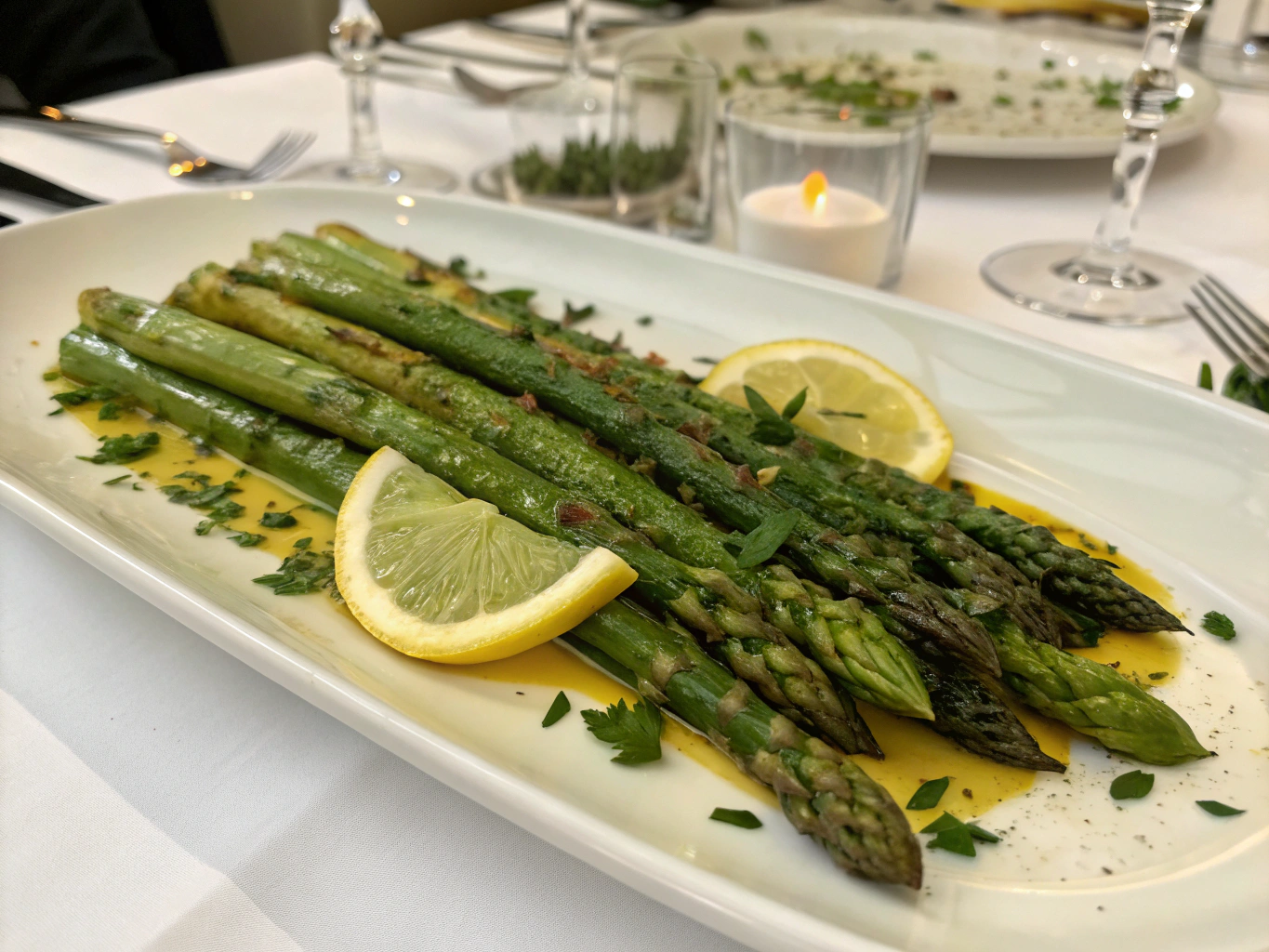
Table of Contents
If you’re searching for a versatile side that’s packed with flavor and requires minimal effort, roasted asparagus is the answer. This article explores every detail about making perfect roasted asparagus—how to choose the best spears, prep them right, season boldly, and avoid common pitfalls. Along the way, I’ll share a personal story about what makes this dish so special to me and provide smart variations, time-saving tricks, and nutritional bonuses. Ideal for weeknight meals or special gatherings, you’ll learn how to elevate this vibrant vegetable with ease.
A Charleston Memory: Discovering Roasted Asparagus
From Grandma’s Stove to Today’s Oven
Roasted asparagus takes me straight back to spring Saturdays in Charleston. I’m MacMar, and I first learned to cook by instinct at my grandmother’s side. While she never roasted asparagus—preferring to sauté it in bacon grease—I discovered this method later in life during a farmer’s market demo. I was intrigued by its minimalism: good olive oil, cracked pepper, and a blast of high heat that transformed each spear into a golden, crispy-tipped wonder.
It wasn’t a fancy kitchen or a culinary degree that taught me this—just curiosity and a reckless amount of experimentation. Like hosting backyard potlucks where charred asparagus vanished faster than the mac and cheese. At FlavivoRecipes.com, I share dishes like these—beloved basics with a twist.
And the thing about roasted asparagus? It’s got this earthy nuttiness once it hits that oven sweet spot. It complements everything, from plant-based weeknight stir-fry recipes to a slice of lemon-dressed grilled salmon. It’s that kind of side dish that doesn’t require you to hover in the kitchen or wield a blowtorch.
Why Roast Asparagus Instead of Steaming or Sautéing?
Roasting asparagus intensifies its grassy, sweet, and subtly bitter flavors. High heat caramelizes the natural sugars, giving a slightly crisp edge without the sogginess that steaming often brings. Oven roasting also reduces active cooking time, letting you work on other dishes or pour that glass of white wine.
It’s also endlessly flexible. Whether you add parmesan, garlic powder, lemon zest, or chili flakes, the base recipe stays forgiving. I’ve even tossed roasted asparagus into plant-forward pasta bakes and used leftovers in wraps the next day. That’s home cooking to me—accessible, adaptive, and downright delicious.
Ingredients, Prep and Perfect Technique for Roasted Asparagus
Fresh and Flexible Ingredients for Roasting Asparagus
Here’s what you’ll need for a simple roasted asparagus recipe that serves four:
- 1 lb fresh asparagus, trimmed
- 2 tbsp olive oil (or avocado oil for a nuttier profile)
- ¼ tsp kosher salt
- ¼ tsp cracked black pepper
- Optional: 1 tsp lemon zest, 2 tbsp grated Parmesan, or ½ tsp garlic powder for extra flavor
Ingredient Substitutions:
- No olive oil? Try melted ghee or a neutral oil like grapeseed.
- Vegan? Skip the cheese or use nutritional yeast for tang.
- Like heat? Add a pinch of red pepper flakes.
For perfectly tender yet crispy roasted asparagus, aim for medium-thick stalks. Skinny spears cook too fast and tend to shrivel.
Timing: How Long and At What Temperature
You’ll need just under 25 minutes total:
| Step | Time |
|---|---|
| Prep (trim & season) | 5 minutes |
| Roast at 400°F (204°C) | 12–15 minutes |
| Total Time | 17–20 minutes |
Roasting asparagus at 400°F ensures quick browning and a soft interior. If you want crispier tips, broil for the last 1–2 minutes.
Step-by-Step: How to Roast Asparagus Like a Pro
- Preheat your oven to 400°F (204°C).
- Wash and trim asparagus—snap the ends naturally or cut the bottom inch.
- Place spears on a baking sheet. Drizzle with oil, toss to coat evenly.
- Sprinkle salt, black pepper, and any optional seasonings.
- Spread them in a single layer. Overlap = steam instead of roast.
- Roast for 12–15 minutes, shaking the pan halfway.
- Optional broil 2 minutes for darker edges.
- Serve immediately or store in an airtight container for up to 3 days.
Tip: Don’t overcrowd your pan. Use two trays if doubling!
Roasted Asparagus Variations and Nutritional Value
Flavor Variations to Customize Every Time
Once you’ve got the basics down, you can take this anywhere:
- Cheese lovers: Sprinkle feta or blue cheese crumbles over warm asparagus.
- Smoky kiss: Add smoked paprika and a dab of chipotle mayo.
- Mediterranean twist: Toss with sliced olives and sun-dried tomatoes.
- Asian flair: Substitute sesame oil and top with toasted sesame seeds.
For example, my balsamic-glazed roasted asparagus grew from too many open bottles of vinegar, but it became one of my most-requested potluck dishes.
Roasting also plays well with proteins, whether folded into chickpea-based stir fry or served alongside grilled tofu.
Health Benefits of Roasted Asparagus and Expert Insight
Asparagus is a powerhouse: low in calories and carbs, high in fiber, folate, and Vitamin K. It supports digestion and heart health—and tastes indulgent without heavy ingredients.
According to Nutrition.gov, it’s got natural antioxidants and strengthens immune functions. That’s one reason it’s worth keeping in regular rotation.
Plus, roasted asparagus retains nutrients better than boiling. The oven caramelizes rather than leeches, leaving you with more vitamins per bite.
Whether you’re eating it with eggs in the morning or wrapping it in a tortilla at lunch, this side dish performs 24/7.
Common Mistakes, Storage Tips & Meal Pairings
Avoid These Mistakes When Roasting Asparagus
Even great cooks overlook these common blunders:
- Roasting with too little oil: causes rubbery texture.
- Using a cold oven: reduces crisp factor.
- Not drying spears after washing: results in steam instead of roast.
- Choosing ultra-thin spears: they dry out fast and get stringy.
Also, don’t skip trimming! The woody ends are fibrous and unpleasant.
If you’re making roasted asparagus with other recipes like veggie-stuffed acorn squash, synchronize the prep so you can maximize oven use and cut down on total cooking time.
Leftovers, Reheating and Ideal Pairings
Storing roasted asparagus:
- Let cool completely before placing in sealed containers.
- Keeps for 3 days in the fridge.
- Best reheated in an oven at 375°F for 5–6 minutes.
Meal Ideas:
- Chop into grain bowls with quinoa and avocado.
- Wrap in tortillas with hummus and red bell pepper for an easy lunch.
- Top with a fried egg for weekend brunch.
Pair it with your mains and favorite plant-based creamy potato soup for a hearty and complete meal.
Use cold roasted asparagus to add crunch to pasta salad with arugula and corn, or tuck it into a warm baguette with mustard for a satisfying vegetarian sandwich.
FAQ About Roasting Asparagus
What temperature do you roast asparagus at?
Roast asparagus at 400°F (204°C) for best results. This temperature browns the tips without overcooking the stalks.
What are common mistakes when roasting asparagus?
Overcrowding the pan, skipping oil, using damp spears, or selecting very thin asparagus are the most common issues. Avoid these for perfectly crisp edges.
Is it better to cook asparagus in the oven or on the stove?
The oven preserves more flavor and nutrients while providing caramelization. Stove methods like sautéing are quicker but can over-soften the texture.
How long to bake asparagus at 400 according to Reddit?
Most users on Reddit—based on popular food threads—suggest 12–15 minutes at 400°F, often flipping once at the 7-minute mark for even roasting.
Conclusion
Roasted asparagus is more than just a quick side—it’s a gateway to nourishing, delicious, and wildly flexible home cooking. From selecting the freshest spears to experimenting with bold flavors, you’ve now got everything you need to perfect this humble veggie. As someone who’s learned from both fiery ovens and joyful kitchen victories, I invite you to make it your own. Whether it’s a minimalist lemon version or one topped with garlic-parm crust, there’s no wrong way to roast.
Let this simple recipe inspire more culinary exploration—and if the smoke alarm does sound, know you’re in good company.
